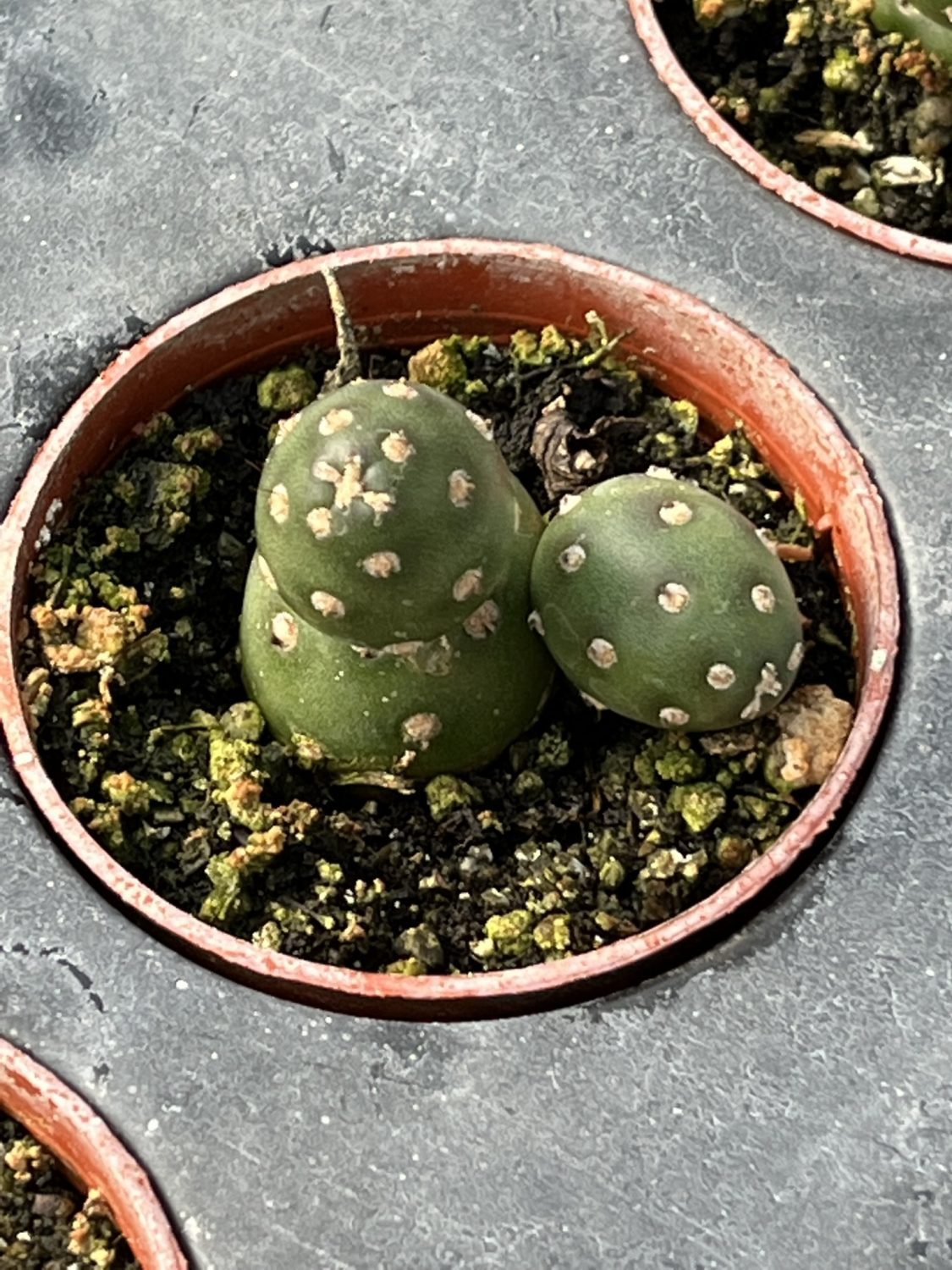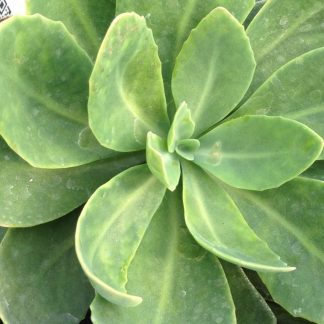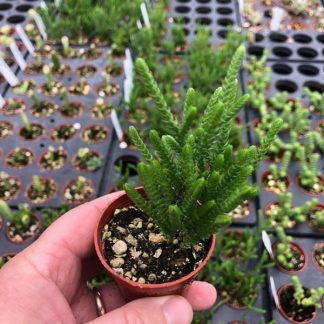Description
Potato Cactus (Opuntia fragilis): Growing and Caring Guide
Introduction
Opuntia fragilis, often called Potato Cactus, is one of the smallest members of the prickly pear family. Though tiny, it is tough. This plant thrives in rocky hills, windy plains, and even snowy woods. In other words, it lives where few other succulents dare to grow. By the end of this guide, you and I will know how to welcome this hardy friend into our own spaces.
Description
A Tiny Survivor
The Potato Cactus hardly reaches four inches tall, yet its spirit feels giant. Each pad is shaped like a plump green potato, round and smooth at first glance. Look closer and you will see tufts of sharp spines and fine hairs called glochids. These hairs act like tiny barbs that stick to skin or fur. They protect the pad from hungry wildlife instead of harming us on purpose. Most of all, they remind us to handle the plant with care.
Natural Range
Opuntia fragilis roams across North America, from the dry deserts of New Mexico up to the cold forests of Alberta. After more than ten thousand years of travel, it learned to handle blazing sun, harsh wind, and surprise ice. Because it breaks into pieces so easily, small pads can hitch a ride on animals, boots, or strong gusts. Each pad roots where it lands, starting a new patch without fuss.
Shape and Size
You might expect a cactus to tower skyward, but this species hugs the ground. Pads grow in clumps, each pad no bigger than a child’s thumb. The joints between pads stay weak by design. When stepped on, the plant sacrifices a pad so the rest may live. The broken pad grows roots within weeks. In time, many pads knit together to form a low green mat that glitters with spines in the morning light.
Flowers and Fruit
Late spring brings a surprise burst of color. Round buds open into golden yellow blooms with hints of orange at the throat. Bees buzz in for pollen and nectar. After pollination, small purple fruit form. These fruit look like tiny plums and add a playful note to the spiny patch. Birds snack on the fruit and then spread the seeds far and wide.
Living With Wildlife
Deer and rabbits rarely bother this cactus. Its main animal partners are pollinators and birds. In dry grasslands, the pads also shelter insects, giving them cool spots under the spines. Our gardens gain a bit of living ecology when we grow this plant.
History and Naming
The first written record of this cactus dates back to 1814 when explorers mapped the upper Missouri River. They noted its brittle nature and named it fragilis, meaning fragile. Yet the common folk called it Potato Cactus because broken pads looked like spilled tubers on dusty paths. Over time, scientists placed it in the wide Opuntia clan, a group named after an ancient Greek city where spiny figs once grew. The mix of Latin and folk names tells a story of science blending with daily life.
Ecological Benefits
When you add Opuntia fragilis to a dry border, you invite more than beauty. Pads serve as tiny reservoirs, storing rainwater that later drips to the soil in slow sips. Their spreading mats anchor loose sand, guarding against wind erosion. Bees and native flies feed on bright pollen at a time when few other flowers bloom. In this way, one small plant weaves itself into a larger web of life.
How to Care for Potato Cactus
Light
Give your cactus bright sun for at least six hours each day. A south-facing bed or window works well. If light is weak, pads stretch thin and pale. That makes them snap before they mature. Sun keeps them short, strong, and bright green instead.
Temperature
This species survives both heat and frost. Summer highs near 110 °F do not stop it, and winter lows down to -30 °F rarely kill it. Still, rapid freeze-thaw swings can split pads. If you live in a wet winter zone, place the pot under a roof edge so rainfall does not soak the soil during cold spells.
Soil
Fast drainage is key. Mix two parts coarse sand or small gravel with one part regular potting mix. Instead of peat, choose coconut coir to hold light moisture while letting air flow. Set the plant on a slope or in a raised bed so water slips away after storms.
Water
Water deeply but seldom. In hot months, soak the soil once every two weeks. Let it dry all the way before the next drink. In cool months, cut water to once a month or even stop if the plant sits outdoors and catches snow. Extra water in cold weather invites rot.
Watering Mistakes and Fixes
Many new growers see shriveling pads and rush to water. Instead of flooding the pot, check root health first. Pads wrinkle slightly during normal dry spells. If they feel firm, wait. If they feel soft, a deep soak is needed. After more than two days, they plump back up. On the other hand, mushy pads signal rot. Trim away the affected pads, shift the pot to stronger light, and reduce watering by half.
Feeding
Potato Cactus needs very little food. A light sprinkle of slow-release cactus fertilizer in spring is enough. Skip high-nitrogen feeds. They push lush growth that breaks easily. In other words, gentle feeding keeps the plant tough.
Potting and Repotting
Choose a wide, shallow pot with holes. Terra-cotta breathes, so roots stay dry. Fill the pot with fresh sandy mix. Use tongs or folded paper to move pads. Repot every three years to refresh soil and trim dead roots. Always wear thick gloves because glochids lodge in skin.
Pruning and Cleaning
Prune only to remove dead or broken pads. Snip the pad at a joint with clean shears. Pads that fall on their own can be gathered and planted elsewhere. Brush away leaves that land on the clump. Leaves trap damp air, which may rot the pads.
Propagation
Propagation is simple. Twist off a firm pad, let the wound dry for three days, and then press the base into gritty soil. Keep the pot in bright shade for a week, then move to sun. Water lightly after roots form. After more than a month, new pads appear, showing success.
Seed Germination
Growing from seed rewards patient gardeners. Collect ripe fruit when it turns deep purple. Scoop out the pulp, rinse the seeds, and dry them for three days. Sow on a mix of sand and pumice. Press them in but do not cover; they need light to sprout. Keep the tray at 70 °F and mist daily. Sprouts appear in three to six weeks. After their first tiny pads harden, move each seedling to its own cell.
Winter Care
In very wet zones, move potted plants under eaves or into an unheated garage. Good airflow prevents mold. Do not water unless pads shrivel badly. Outdoor plants in dry cold need no help. Snow acts like a blanket and melts fast through the porous soil.
Common Pests and Problems
Root rot is the main foe. Good drainage and lean watering stop it. Mealybugs sometimes hide in joints. Dab them with alcohol on a cotton swab. Glochids in skin sting, but sticky tape lifts them off. Tweezers also help, yet tape is gentler.
Designing With Potato Cactus
In the Garden
Use this cactus in rock gardens, sunny slopes, or xeric beds. Pair it with stones of mixed size to mimic its wild scene. Spreading clumps prevent soil erosion on small hillsides. Because the plant stays low, it makes a neat border along walkways that receive little foot traffic.
In Pots and Indoors
A bowl planter on a sunny deck or windowsill turns the plant into living sculpture. Mix it with mini agaves, ice plants, or sedums for varied shapes. Indoors, place the pot near a south or west window. Rotate the bowl every two weeks so all sides get light. If you use grow lights, set them about twelve inches above the pads and run them twelve hours a day.
Companion Plants
Choose hardy partners that love dry feet. Blue fescue, thyme, and Artemisias create soft clouds next to the spiky pads. In spring, low tulips can bloom between clumps, their red and yellow tones matching the cactus flowers. Instead of thirsty annuals, pick drought-smart natives to build a balanced scene.
Safe Handling
Teach children and guests to watch, not touch. Keep the plant at least two feet from busy paths. When you must handle it, wear leather gloves and long sleeves. Use kitchen tongs rather than bare fingers. After working, check clothes for loose glochids before you head indoors.
Crafts and Creative Uses
Dried pads make quirky ornaments for garden wreaths. In some regions, people peel mature pads, dry them flat, and paint tiny desert scenes on the flesh. Children enjoy using fallen spines as natural “needles” to thread beads on fine string. Always supervise these projects and file the barbs off first. Instead of tossing broken pads, turn them into art and share the story of resilience with friends.
Fun Facts and Folklore
Indigenous peoples once ate the fruit fresh and dried the pads for winter use. The pads taste a bit like green beans when young and de-spined. Early settlers called it Potato Cactus because the pads looked like tiny potatoes spread on the ground. In some regions, locals believed the plant could ward off evil due to its sharp armor.
Frequently Asked Questions
Why do my pads drop after rain?
Pads detach to spread the plant in nature. Too much water may weaken joints. Let the soil dry deeper and add more grit next time.
Can I grow it in humid climates?
Yes, but lift the bed and add gravel. Morning sun and afternoon breeze help dry pads faster.
How fast does it grow?
Slow but steady. Expect two to three new pads per year when care is right.
Will it bloom indoors?
Indoor light rarely matches outdoor sun. Move the pot outside for summer to boost blooms.
Are the spines dangerous to pets?
Cats and dogs avoid the pads after one sniff. Still, place the pot out of reach to be safe.
Frequently Asked Questions (More)
How do I remove glochids from skin?
Press duct tape over the spot, then pull. Repeat with fresh tape until the sting eases.
Can I eat the fruit?
Yes, but peel the skin to avoid glochids. The taste is mildly sweet, like a berry mixed with cucumber.
Gentle Parting Rays of Inspiration
Together, we explored the wonders of Opuntia fragilis, the humble Potato Cactus. We learned how it thrives in rocky soil, bright sun, and cold nights. We saw easy ways to plant, water, and share new pads with friends. Now it is your turn. Bring this tiny desert gem into your space and watch resilience grow in miniature form. May its steadfast nature remind us that even the smallest life can stand strong under wide-open skies.




